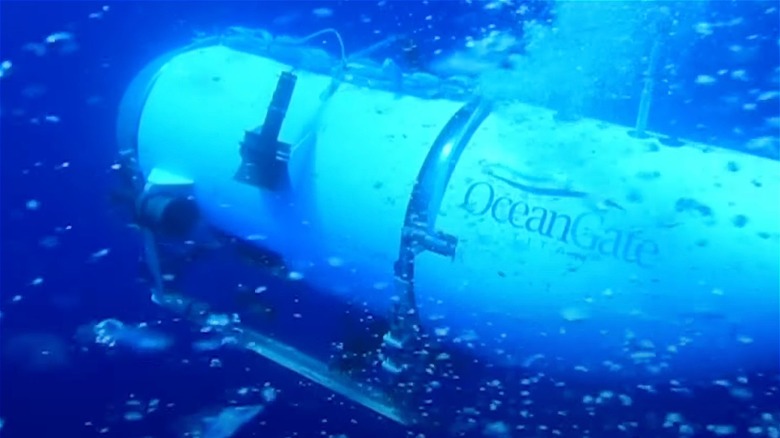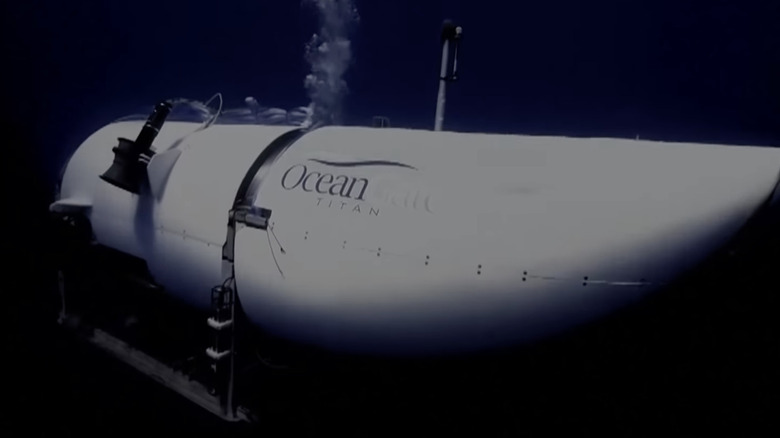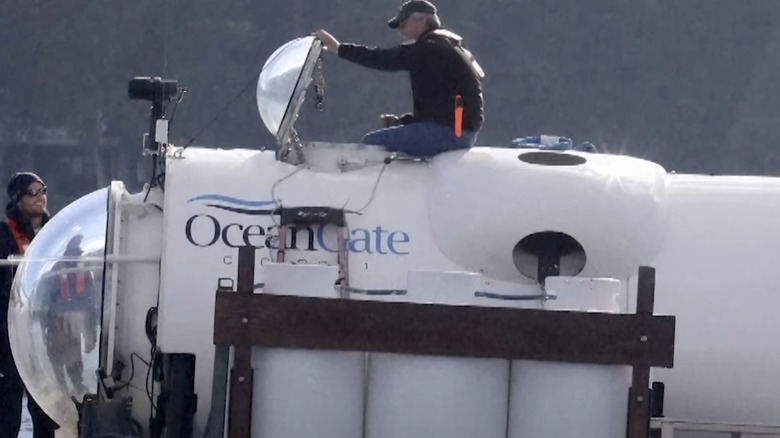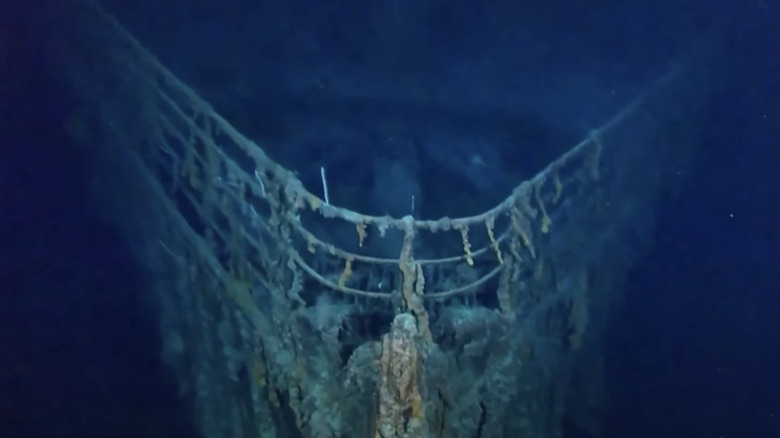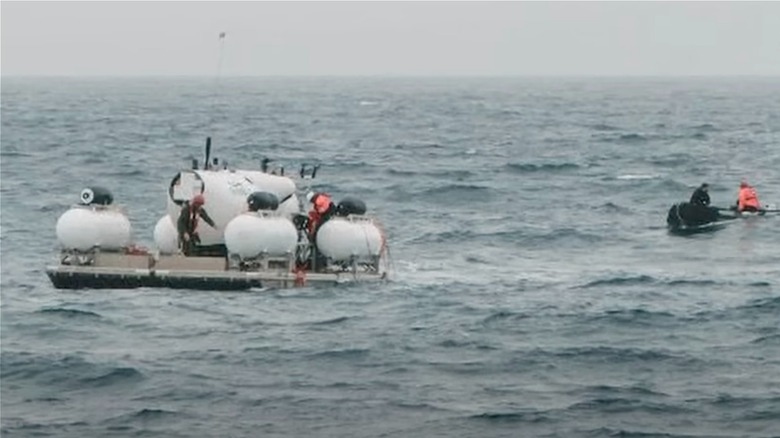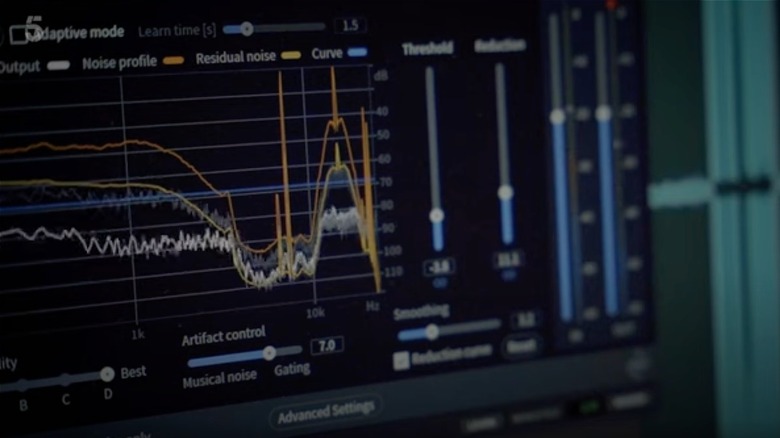Disturbing Details From The Titan Sub Disaster: Minute By Minute Documentary
In June 2023, a deep-sea submarine called Titan brought five people to view the aftermath of a historical event: what remained of the Titanic, which sank in 1912. Similar to how hundreds died onboard that ocean liner, Titan was destined for tragedy as well. In early March 2024, U.K. television broadcaster Channel 5 aired the two-part "The Titan Sub Disaster: Minute by Minute." The harrowing documentary is among the first all-encompassing, full-length films to chronicle the entire sad story of Titan, from background to launch to attempted rescue to recovery.
Makers of "The Titan Sub Disaster: Minute by Minute" compiled publicly known information about the then-recent tragedy while also interviewing people close to the situation and those directly involved. The film also uncovers startling information about Titan not yet available to the world at large, as well as never-before-seen (or heard) footage captured as it happened. Here, then, is every frightening and upsetting thing there is to know about the hows and whys of the Titan disaster, from its first exhaustive chronicle.
Titan wasn't in great shape before its dive
As discussed and explored in "The Titan Sub Disaster: Minute by Minute," the Titan submersible was already in a compromised state before it even began its intended descent to view the remains of the Titanic in June 2023. By that time, Stockton Rush, a not particularly well-trained but experienced submersible pilot, had reportedly taken paying guests on more than a dozen Titanic dives into the Atlantic Ocean, putting a lot of wear and tear on the vessel from the ocean in terms of water pressure. Even worse: Rush utilized a sub design he thought would be innovative and less expensive, fusing two titanium ends to a central core of carbon fiber. Generally, submersibles use more titanium for that section rather than carbon, because it's stronger and more durable.
Not only was Titan built from experimental materials that had been weathered by the ocean, but on the day of what would be its final descent in 2023, operators at Rush's company, OceanGate, transported it to the dive site by towing it behind a rented ship, the Polar Prince. In "The Titan Sub Disaster: Minute by Minute," marine engineer Bart Kemper said that in order to eliminate unnecessary damage through "vibration, impact, and exposure," the team should've moved the submersible by hauling it out on the deck of the ship. The Polar Prince was simply too small to make such an accommodation.
Titan hit the sea far too early in the year
According to "The Titan Sub Disaster: Minute by Minute," the first instance of tragic foreshadowing occurred well before the submersible's final voyage to the bottom of the sea on June 18, 2023. In its previous Titanic viewing trips, Titan departed Newfoundland in July and August — the heart of the summer, when the Atlantic Ocean is reasonably calm and warm, or at least more so than it is in June. Hamish Harding, a billionaire who paid $200,000 for a spot on Titan, announced on Facebook on June 17 (according to Reuters), "A weather window has just opened up and we are going to attempt a dive tomorrow." However, those clear conditions were an aberration, of which Harding and others were keenly aware. "Due to the worst winter in Newfoundland in 40 years, this mission is likely to be the first and only manned mission to the Titanic in 2023," he wrote.
OceanGate CEO and Titan builder Stockton Rush knew that the weather wasn't completely summer-like, however, which is why he decided to risk a Titanic mission so early. He admitted to associates that he wanted to see large chunks of ice, or even an iceberg, just like the one that destroyed the Titanic, to heighten his customers' experience of traveling to see that famously downed ship.
Weather delayed Titan's launch
"The Titan Sub Disaster: Minute by Minute" provides much context to the compressed timeline of the events involving the Titan sub launch, accident, and recovery. Viewers are able to comprehend the situation a bit more thanks to footage and first-hand accounts of what happened with the submersible and its ship escort, the Polar Prince, in the hours leading up to its ill-fated voyage to the Titanic site. The Polar Prince arrived at the mapped-out Titanic dive site well before dawn on Sunday, June 18, 2023, with the intent to launch Titan at 4 a.m. But despite the declaration and supposition on the previous day of good launch-day weather, it was an uncharacteristically foggy day off the coast of Newfoundland that morning, and the Polar Prince and Titan personnel had to wait until the fog lifted or dissipated to make for as safe a start as possible.
But, as "The Titan Sub Disaster" depicts, OceanGate CEO and submersible leader Stockton Rush became increasingly agitated and annoyed the longer he had to wait. That's just one red flag of many that suggested doom for Titan. Finally, with Rush pushing for the voyage to begin as soon as possible, the submersible began its descent at 8 a.m.
Passengers were fully and repeatedly made aware of the dangers
Producers of "The Titan Sub Disaster" used amateur video footage of OceanGate CEO and submersible pilot Stockton Rush (pictured) briefing passengers before a previous Titanic viewing voyage. While people who knew and worked with Rush interviewed for the documentary characterized the entrepreneur as an optimistic maverick, Rush soberly informs prior Titan adventurers of the full risks of the dive, chiefly that his vessel, however impressive he finds it, is experimental and thus unreliable. He assures any nervous paying passengers that they will have an "out" if they want to back out before the descent begins in earnest.
"The Titan Sub Disaster" goes on to detail the legalities and paperwork Titan passengers, including those on the fatal 2023 trip, faced. For example, each was required to sign a multi-page waiver that mentions the possibility of death several times on page one. However, in a chilling turn of events, an opt-out may not have been so easy. Immediately after signing the waiver, passengers were loaded into the tight and tiny submersible. A crew then closed a hatch and bolted it shut behind them from the outside — before the vessel's safety check. At that point, and even before the sub was underwater, there was no turning back.
[Featured image by OceanGate via Wikimedia Commons | Cropped and scaled | CC BY 3.0]
Titan never got close to the Titanic
According to news reports and the documentary "The Titan Sub Disaster: Minute by Minute," the submersible encountered trouble at 9:45 a.m., less than two hours after it began its descent into the Atlantic Ocean. At that moment, the sub lost all communication with the surface. Marine engineers and sub experts interviewed in the documentary, including "Titanic" film director James Cameron, theorize that onboard Titan, a system alert warning of a hull failure sounded, and the crew likely dropped its ascent weights in an attempt to head back to the surface. It's unknown what exactly happened, or what happened next, due to the communications outage. Judging by the usual speed of Titan's descent, it's unlikely that the vessel was far enough along to view the Titanic crash site.
Later in the documentary, it's definitively revealed that Titan passengers indeed never got to see the Titanic at any point in their journey. The sub never fully descended because the moment it lost communications, it suffered a virtually simultaneous violent episode that led to instant and complete destruction.
If Titan had resurfaced, it still would have faced dangers
Although prepared and produced many months after the events depicted, when most mysteries had been solved as to just what happened to cause a submersible voyage to end in the deaths of its passengers, "The Titan Sub Disaster: Minute By Minute" spends a significant amount of time speculating on life inside that sub, and what awful possibilities the people involved may have faced. For example, before it became clear that Titan had violently come apart underwater, rescuers entertained the possibility that the sub had resurfaced and drifted far away from the initial dive site. Concerted rescue efforts included Canadian military planes scanning an area as wide as 7,500 square miles, looking for life.
This wouldn't necessarily have resulted in a happy ending. Even if Titan had made it back to the surface of the Atlantic Ocean, its occupants probably wouldn't have been able to get out. A total of 15 bolts locked the vessel into an air-tight state, from the outside. Had the vessel reemerged, and if it were not spotted by rescuers by the time oxygen stores were depleted, the passengers could have frozen to death or asphyxiated while viewing the outside world, and its breathable air, through porthole windows.
The Navy knew what happened right away but didn't reveal much
Just a few hours into the Titan rescue drive, equipment operated by both the U.S. and Canadian navies detected a sound that emanated from near the known final resting place of the Titanic wreckage. As that's where Titan was heading, it seemed likely that the submersible was responsible for the sound. Analysis by the U.S. Navy determined that the sound was "an anomaly consistent with an implosion or explosion," a naval official told NPR. Essentially, and as explained by "The Titan Sub Disaster: Minute by Minute," high-ranking members of the search and rescue squad knew that Titan had imploded — destroyed and torn asunder under the weight of tremendous water pressure — before the sub had even been reported missing. The five days of hopeful searching for an intact ship with a live crew was ultimately all for naught, and the U.S. Navy didn't reveal this until after the Odysseus 6 submersible discovered Titan rubble.
The good news, according to the documentary, which emphasized the profound and tragic loss of human life in the submersible: The five people who died didn't suffer. As the search went on for several days, authorities worried that the stranded passengers may have endured claustrophobia, psychological trauma, panic, hypothermia, or a painful death from asphyxiation when their oxygen ran out. Instead, because Titan imploded, they died instantly and painlessly, owing to how the human body reacts to implosion.
A banging sound mystified rescuers
The eeriest part of the Titan story reached the public for the first time via "The Titan Sub Disaster: Minute by Minute." On June 20, 2023, about two days after Titan disappeared, Canadian military plane-based sonar devices detected a rhythmic banging sound, delivered in a "tap-tap, tap-tap" sequence, which repeated around every half hour. Also described as a knocking sound, the noises bore a distinctive metallic ring. "The Titan Sub Disaster: Minute by Minute" plays a recording of the sounds several times, demonstrating how such a discovery charged and inspired the rescue team. Individuals associated with the rescue effort thought it could be the sound of someone inside Titan banging on a wall, attempting to call for help with the only method available, as the communications system had failed by this point. Another take on the sound, proposed by the documentary: It was the sound of metal wrenching apart.
It's more likely that the ominous or hopeful banging had nothing to do with Titan. Those sounds could have come from another surface-level ship nearby, or been generated by metallic objects in the ever-shifting sunken debris of the Titanic. It likely wasn't a distress call, because there's a certain protocol of sounds sub crews are supposed to engage when their vessel sinks and communication systems fail. Additionally, it was later determined that Titan had already imploded well before the transmission of the metal banging sounds.
The rescue attempt almost failed at the last minute
"The Titan Sub Disaster: Minute by Minute" includes an extensive firsthand account of the submersible rescue efforts from Ed Cassano, CEO of Pelagic Research Services, owner and operator of a remote-operated, highly sophisticated submersible capable of withstanding depths even greater than that of Titan. Government agencies contacted Pelagic, which, thanks to a U.S. Air Force transport of its vessel, arrived at the dive site and made its descent just past 4 a.m. on Thursday, June 22 — four days after Titan failed to materialize and with an estimated five hours of oxygen remaining in the ship, if it were still stranded and whole. Pelagic workers plunged its vessel, Odysseus 6, at a faster rate than usual because time was of the essence — 35 meters per minute, versus 25 meters.
At 6:15 a.m., with two hours of theoretical oxygen left on Titan, Odysseus 6 encountered a technical issue. Its thrusters failed, rendering it entirely useless. Workers had few options besides turning off the system and turning it back on again. That method worked, and Odysseus 6 continued its briefly delayed descent. When it landed on the ocean floor, Titan would likely have had little to no breathable air left, making the Odysseus 6's efforts at this stage all the more critical.
Titan debris revealed the truth
When the moment that Titan was predicted to run out of oxygen came and went on Thursday, June 23, 2023, rescuers continued to work, even though the possibility that the passengers on the submersible were still alive diminished with every moment. According to "The Titan Sub Disaster: Minute by Minute," the team from Pelagic quickly and soberly changed focus from rescue to recovery, an increasingly likely outcome for Titan.
Four hours into the revamped mission, the Odysseus 6's cameras made a grisly and haunting discovery in Titan's debris field: a large piece of metal, unmistakably the tail cone of Titan. The remote-controlled sub found this remnant on the ocean floor just 1,600 feet from the bow of the Titanic, Titan's intended destination. Experts observed that the state of the cone bore signs of implosion. Over the next four days, the Pelagic team led the debris collection effort, which continued without pause and involved six dives of Odysseus 6. On June 28, a ship hauled back what the Odysseus 6 could locate of Titan. When the fragments were returned to the docks in Newfoundland, reporters noted how the pieces were immediately recognizable as submarine parts, like an intact nose cone, strands of the hull, and portholes with the glass blown out.
Titan's end was predicted
Millions closely followed the events surrounding the hunt for the Titan submersible, transfixed by the dramatic and unpredictable situation. While many held out hope that the five people inside the deep-sea vessel were still alive several days after the sub failed to resurface, the handful of people familiar with OceanGate and its CEO Stockton Rush, along with marine vehicle experts, found it tough to stay optimistic — they'd ominously and fearfully predicted Titan's ultimate fate.
"There are those that have said it's just a question of not if but when something would go wrong," marine engineer Bart Kemper said in "The Titan Sub Disaster: Minute by Minute." He was also a signatory on a letter (displayed in the documentary) sent to Rush in March 2018. Fearing a "Hindenburg event" — meaning a faulty sub responsible for the deaths of innocents, as had happened for those traveling on the Hindenburg airship in 1937 — the Marine Technology Society's letter urged Rush to pull back with his submersible, to carefully think out every aspect of its construction and use. According to footage of Rush in the documentary, the CEO bragged about cutting corners and breaking rules, proudly proclaiming himself to be an innovator and a rogue. Rush was particularly pleased with himself for building Titan out of two titanium capsules and imperfectly bonding carbon fiber. That lack of stability helped lead to the deadly implosion that would destroy Titan and kill everyone on board.
